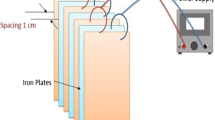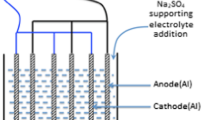Abstract
This study focuses on the mechanism of Nitrate (NO3−) removal from aqueous solutions by electrocoagulation (EC) using aluminum (Al) and iron (Fe) electrodes and on the reduction of high nitrate levels in the groundwater of an arid/semi-arid region. Influence of initial pH, varying electrode material, inter-electrode distance, initial conductivity, and nitrate concentration over percentage removal of nitrate as well as energy consumption were all studied. The process was carried out by batch method at room temperature (25 °C). Tests were performed on a synthetic water sample prepared in the laboratory and ten samples collected from the Harran Plain region. According to the results of experimental studies, optimum experimental conditions were found to be with Al electrodes and initial pH = 6, run time = 210 min, current density = 2.31 A/m2, inter-electrode distance = 10 mm, and conductivity = 1000 µs/cm for removal of 80.1% nitrate (initial concentration = 250 mg/L). The energy consumption for experimental setup and real groundwater were 2.07 kWh/m3 and 1.925 kWh/m3, respectively. As the Al electrode distance was increased from 10 to 20 mm, the percentage of nitrate removal decreased from 80.1 to 62.3% because of the decrease in electrostatic attraction. It was found that Fe electrodes did not have a significant effect on nitrate removal (12.4%). The removal efficiency of Ugurlu groundwater that has the highest nitrate concentration was found to be 62.0% for Al electrode and 39.0% for Fe electrode. The Al-Al electrode combination used in the studies yielded better efficiency than the Fe–Fe electrode combination. It is thought that this method will also be applicable to regions with the same characteristics as the arid/semi-arid study region.











Similar content being viewed by others
References
Amarine M, Lekhlif B, Mliji EM, Echaabi J (2020a) Nitrate removal from groundwater in Casablanca region (Morocco) by electrocoagulation. Groundw Sustain Dev. https://doi.org/10.1016/j.gsd.2020.100452
Amarine M, Lekhlif B, Sinan M, El Rharras A, Echaabi J (2020b) Treatment of nitrate-rich groundwater using electrocoagulation with aluminum anodes. Groundw Sustain Dev 11:100371. https://doi.org/10.1016/j.gsd.2020.100371
Amooey AA, Ghasemi S, Mirsoleimani-azizi SM, Gholaminezhad Z, Chaichi MJ (2014) Removal of diazinon from aqueous solution by electrocoagulation process using aluminum electrodes. Korean J Chem Eng 31:1016–1020. https://doi.org/10.1007/s11814-014-0032-4
Bensadok K, Benammar S, Lapicque F, Nezzal G (2018) Electrocoagulation of cutting oil emulsions using aluminium plate electrodes. J Hazard Mater 152:423–430. https://doi.org/10.1016/j.jhazmat.2007.06.121
Bhatnagar A, Sillanpää M (2011) A review of emerging adsorbents for nitrate removal from water. Chem Eng J 168:493–504. https://doi.org/10.1016/j.cej.2011.01.103
Chen X, Chen G, Yue PL (2000) Separation of pollutants from restaurant wastewater by electrocoagulation. Sep Purif Technol 19:65–76. https://doi.org/10.1080/01496390601120557
Chen J, Wu H, Qian H (2016) Groundwater nitrate contamination and associated health risk for the rural communities in an agricultural area of Ningxia, northwest China. Expo Health 8:349–359. https://doi.org/10.1007/s12403-016-0208-8
Dash BP, Chaudhari S (2005) Electrochemical denitrification of simulated groundwater. Water Res 39:4065–4072
Durmaz H, Ardıç M, Aygün O, Genli N (2007) Nitrate and nitrite levels in well waters in Sanliurfa region. Van Vet J 18:51–54
El Ouardi M, Qourzal S, Alahiane S, Assabbane A, Douch J (2015) effective removal of nitrate ions from aqueous solution using new clay as potential low-cost adsorbent. J Encapsul Adsorpt Sci 5:178–190. https://doi.org/10.4236/jeas.2015.54015
Elyanow D, Persechino J (2005) Advances in Nitrate Removal, water and process technologies. Available from: http://www.gewater.com/Americas/English/TP1033EN.pdf.
Emamjomeh MM, Sivakumar M (2009) Denitrification using a monopolar electrocoagulation/ flotation (ECF) process. J Environ Manage 91:516–522. https://doi.org/10.1016/j.jenvman.2009.09.020
Epstein R, Nir O, Lahav O, Green M (2015) Selective nitrate removal from groundwater using a hybrid nanofiltration-reverse osmosis filtration scheme. Chem Eng J 279:372–378. https://doi.org/10.1016/j.cej.2015.05.010
Govindan K, Noel M, Mohan R (2015) Removal of nitrate ion from water by electrochemical approaches. J Water Process Eng 6:58–63. https://doi.org/10.1016/j.jwpe.2015.02.008
Graça NS, Ribeiro AM, Rodrigues AE (2019) Modeling the electrocoagulation process for the treatment of contaminated water. Chem Eng Sci 197:379–385. https://doi.org/10.1016/j.ces.2018.12.038
Hakiziman JN, Gourich B, Chafi M, Stiriba Y, Vial C, Drogui P, Naja J (2017) Electrocoagulation process in water treatment: a review of electrocoagulation modeling approaches. Desalination 404:1–21. https://doi.org/10.1016/j.desal.2016.10.011
Hashim KS, Shaw A, Khaddar RA, Pedrola MO, Phipps D (2017) Energy efficient electrocoagulation using a new flow column reactor to remove nitrate from drinking water: experimental, statistical, and economic approach. J Environ Manage 196:224–233. https://doi.org/10.1016/j.jenvman.2017.03.017
Jeong JY, Kim HK, Kim JH, Park JY (2012) Electrochemical removal of nitrate using ZVI packed bed bipolar electrolytic cell. Chemosphere 89:172–178. https://doi.org/10.1016/j.chemosphere.2012.05.104
Jotin R, Ibrahim S, Halimoon N (2012) Electro coagulation for removal of chemical oxygen demand in sanitary landfill leachate. Int J Environ Sci 3:107–110
Kodera T, Akizuki S, Toda T (2017) Formation of simultaneous denitrification and methanogenesis granules in biological wastewater treatment. Process Biochem 58:252–257. https://doi.org/10.1016/j.procbio.2017.04.038
Koparal AS, Ogutveren UB (2002) Removal of nitrate from water by electroreduction and electrocoagulation. J Hazard Mater 89:83–94
Kumar NS, Goel S (2010) Factors influencing arsenic and nitrate removal from drinking water in a continuous flow electrocoagulation (EC) process. J Hazard Mater 173:528–533. https://doi.org/10.1016/j.jhazmat.2009.08.117
Lacasa E, Cañizares P, Sáez C, Fernández FJ, Rodrigo MA (2011) Removal of nitrates from groundwater by electrocoagulation. Chem Eng J 171:1012–1017
Lacasa E, Cañizares P, Sáez C, Martínez F, Rodrigo MA (2013) Modelling and cost evaluation of electro-coagulation processes for the removal of anions from water. Sep Purif Technol 107:219–227. https://doi.org/10.1016/j.seppur.2013.01.035
Li M, Feng C, Zhang Z, Lei X, Chen R, Yang Y, Sugiura N (2009) Simultaneous reduction of nitrate and oxidation of by-products using electrochemical method. J Hazard Mater 171:724–730
Malakootian M, Yousefi N, Fatehizadeh A (2011) Survey efficiency of electrocoagulation on nitrate removal from aqueous solution. Int J Environ Sci Technol 8:107–114. https://doi.org/10.1007/BF03326200
Martinez J, Ortiz A, Ortiz I (2017) State-of-the-art and perspectives of the catalytic and electrocatalytic reduction of aqeuous nitrates. Appl Catal B-Environ 207:42–59. https://doi.org/10.1016/j.apcatb.2017.02.016
Menkouchi Sahli MA, Tahaikt M (2006) Technical optimization of nitrate removal for groundwater by ED using a pilot plant. Desalination 189:200–208. https://doi.org/10.1016/j.desal.2005.06.025
Moussa DT, El-Naas MH, Nasser M, Al-Marri MJ (2017) A comprehensive review of electrocoagulation for water treatment: potentials and challenges. J Environ Manage 186:24–41. https://doi.org/10.1016/j.jenvman.2016.10.032
Ortiz JM, Expósito E, Gallud F, García-García V, Montiel V, Aldaz VA (2008) Desalination of underground brackish waters using an electrodialysis system powered directly by photovoltaic energy. Sol Energy Mater Sol 92:1677–1688. https://doi.org/10.1016/j.solmat.2008.07.020
Palko JW, Oyarzun DI, Ha B, Stadermann M, Santiago JG (2018) Nitrate removal from water using electrostatic regeneration of functionalized adsorbent. Chem Eng J 334:1289–1296. https://doi.org/10.1016/j.cej.2017.10.161
Pirsaheb M, Khosravi T, Sharafi K, Mourad M (2015) Comparing operational cost and performance evaluation of electrodialysis and reverse osmosis systems in nitrate removal from drinking water in Golshahr, Mashhad. Desalin Water Treat 57:5391–5397. https://doi.org/10.1080/19443994.2015.1004592
Pulkka S, Martikainen M, Bhatnagar A, Sillanpää M (2014) Electrochemical methods for the removal of anionic contaminants from water: a review. Sep Purif Technol 132:252–271. https://doi.org/10.1016/j.seppur.2014.05.021
Rodziewicz J, Mielcarek A, Janczukowicz W, Jóźwiak T, Struk-Sokołowska J, Bryszewski K (2019) The share of electrochemical reduction, hydrogenotrophic and heterotrophic denitrification in nitrogen removal in rotating electrobiological contactor (REBC) treating wastewater from soilless cultivation systems. Sci Total Environ 683:21–28. https://doi.org/10.1016/j.scitotenv.2019.05.239
Rodziewicz J, Mielcarek A, Janczukowicz W, Bryszewski K (2020) Electric power consumption and current efficiency of electrochemical and electrobiological rotating disk contactors removing nutrients from wastewater generated in soil-less plant cultivation systems. Water 12:213–222. https://doi.org/10.3390/w12010213
Sadler R, Maetam B, Edokpolo B, Connell D, Yu J, Stewart D, Park MJ, Gray D, Laksono B (2016) Health risk assessment for exposure to nitrate in drinking water from village wells in Semarang, Indonesia. Environ Pollut 216:738–745. https://doi.org/10.1016/j.envpol.2016.06.041
Samatya S, Kabay N, Yuksel U, Arda M, Yuksel M (2006) Removal of nitrate from aqueous solution by nitrate selective ion exchange resins. React Funct Polym 66:1206–1214. https://doi.org/10.1016/j.reactfunctpolym.2006.03.009
Shivayogimath CB, Watawati C (2013) Treatment of solid waste leachate by electrocoagulation technology. Int J Res Eng Technol 2:266–269
Tyagi S, Rawtani D, Khatri N, Tharmavaram M (2018) Strategies for nitrate removal from aqueous environment using nanotechnology: a review. J Water Process Eng 21:84–95. https://doi.org/10.1016/j.jwpe.2017.12.005
Un UT, Koparal AS, Ogutveren UB (2013) Fluoride removal from water and wastewater with a batch cylindrical electrode using electrocoagulation. Chem Eng J 223:110–115
Vasudevan S, Epron F, Lakshmi J, Ravichandran S, Mohan S, Sozhan G (2010) Removal of NO3- from drinking water by electrocoagulation-an alternate approach. Clean-Soil Air Water 38(3):225–229
WHO (2011) Guidelines for drinking-water quality. WHO Chronicle 38:104–108
Yazdanbakhsh AR, Kashefiasl M, Zareh H, Agaiani E, Sardar M, Sheikhmohammadi A (2015a) Thickening of biological sludge by electro-coagulation-flotation process. Int J Electrochem Sci 10(3):746–756
Yazdanbakhsh AR, Massoudinegad MR, Eliasi S, Sheikh Mohammadi A (2015b) The influence of operational parameters on reduction of Azithromyin COD from wastewater using the peroxi-electrocoagulation process. J Water Process Eng 6:51–57. https://doi.org/10.1016/j.jwpe.2015.03.005
Yazici Karabulut B, Atasoy AD, Yesilnacar MI (2019a) Investigation of the effect of montmorillonite clay on aluminum amount and flock form in nitrate removal by electrocoagulation process. Int J Math Eng Natural Sci 8:135–142
Yazici Karabulut B, Atasoy AD, Yesilnacar MI (2019b) Removal of nitrate from aqueous solutions by batch electrocoagulation process using al and fe plate electrodes. Harran Univ J Eng 4:79–88
Yazici Karabulut B, Atasoy AD, Yesilnacar MI (2019c) Fluoride contamination in groundwater and its removal by adsorption and electrocoagulation processes. Sigma J Eng Nat Sci 37(4):1247–1258
Yehya T, Chafi M, Balla W, Vial C, Essadki A, Gourich B (2014) Experimental analysis and modeling of denitrification using electrocoagulation process. Sep Purif Technol 132:644–654. https://doi.org/10.1016/j.seppur.2014.05.022
Yeşilnacar MI, Güllüoğlu MS (2008) Hydrochemical characteristics and the effects of irrigation on groundwater quality in Harran Plain, GAP project, Turkey. Environ Geol 54:183–196
Yesilnacar MI, Uyanik S (2005) Investigation of water quality of the world’s largest irrigation tunnel system, the Sanliurfa tunnels in Turkey. Fresenius Environ Bull 14:300–306
Yesilnacar MI, Sahinkaya E, Naz M, Ozkaya B (2008) Neural network prediction of nitrate in groundwater of Harran Plain. Turkey Environ Geol 56:19–25. https://doi.org/10.1007/s00254-007-1136-5
Zhang Z, Han Y, Xu C, Ma W, Han H, Zheng M, Zhu H, Ma W (2018) Microbial nitrate removal in biologically enhanced treated coal gasification wastewater of low COD to nitrate ratio by coupling biological denitrification with iron and carbon microelectrolysis. Bioresour Technol 262:65–73. https://doi.org/10.1016/j.biortech.2018.04.059
Acknowledgements
This study was funded by the Scientific Research Projects Committee of Harran University, (HUBAP) under Project No. 17199.
Author information
Authors and Affiliations
Corresponding author
Ethics declarations
Conflict of interest
The authors declare that they have no conflict of interest.
Additional information
Publisher's Note
Springer Nature remains neutral with regard to jurisdictional claims in published maps and institutional affiliations.
Rights and permissions
About this article
Cite this article
Yazici Karabulut, B., Atasoy, A.D., Can, O.T. et al. Electrocoagulation for nitrate removal in groundwater of intensive agricultural region: a case study of Harran plain, Turkey. Environ Earth Sci 80, 190 (2021). https://doi.org/10.1007/s12665-021-09488-8
Received:
Accepted:
Published:
DOI: https://doi.org/10.1007/s12665-021-09488-8




